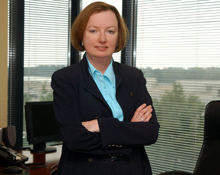Campus News
March 1, 2010
Investing for the future

Mary Cahill
Nine years ago, Mary Cahill, Emory’s vice president for investments and chief investment officer, began to build and lead Emory Investment Management, the team that manages Emory’s endowment and related financial assets. The financial crisis and market turmoil, which occurred in fiscal year 2009, created many challenges for university endowments and resulted in Emory’s endowment realizing a -14.5 percent return. Cahill reflects on the last fiscal year and the beginning of a recovery, why a long-term perspective is essential, and positioning the assets for the future.
Emory Report: What lessons were learned from the financial market crisis?
Mary Cahill: In the midst of the crisis, communications with our external managers, University finance leaders, and trustees fended off some of the potential losses. Our emphasis on risk management also helped. We were reminded of the importance of acknowledging the unexpected, maintaining a focus on price versus value, and of the benefits of remaining nimble. We still face complex issues resulting from the major realignment of the financial system, unprecedented government intervention, massive increases in government deficits and government debt throughout the world, and the erosion of trust in the market system.
ER: Recently you noted some limited recovery of Emory’s endowment during the last several months of 2009. What is the current state of the endowment?
Cahill: After the disappointing performance for fiscal year 2009, we have started to see some improvements. Preliminary figures for Sept. 1-Dec. 31, 2009, show a 5.5 percent gain in Emory’s endowment. That’s welcome news, but it will take a more significant market rally to return us to our position at the peak. Given our expectations for returns and spending, and because we believe economic growth will not be as strong as experienced in past recoveries, it is possible that a return to the previous endowment peak levels will not occur for a decade or more. But I remind people that our management of the endowment is like an epic marathon. We are working to preserve and grow the endowment for generations in the future, so we naturally take a long-term view of its performance.
ER: How have your views and/or positioning of the portfolio changed?
Cahill: Emory Investment Management allocates endowment assets to 140 external investment managers and we remain focused on finding the best, most skilled investment managers around the globe. The acceleration of globalization is a prominent theme in all of our investment decisions. We believe the pace of innovation has a profound effect on investing and market opportunities and have shifted our emphasis somewhat to put more value on liquidity, to be more opportunistic in our capital allocations, and to refine our risk management efforts.
Our team’s investment decisions are informed by diverse perspectives and collaborative generation of ideas with dissonance in pursuit of excellence. We are passionate about what we do. We work hard, competitively, and think globally. We have confidence that we will be effective with structuring the portfolio for future challenges as they arise.
ER: What causes concern for you in the market today?
Cahill: Investing has always required the consideration of scores of possible outcomes. Emory managed to avoid or mitigate some of the market failures during the turmoil by worrying about such problems before they occurred. As a result we fared better than a number of the large endowments. While the markets and economy have improved, we are still facing a great deal of uncertainty and remain rather defensive in our portfolio positioning. And, although I must say that my threshold for angst is different than what it was a couple of years ago, our process for gathering and analyzing information does give me some comfort for the future.
